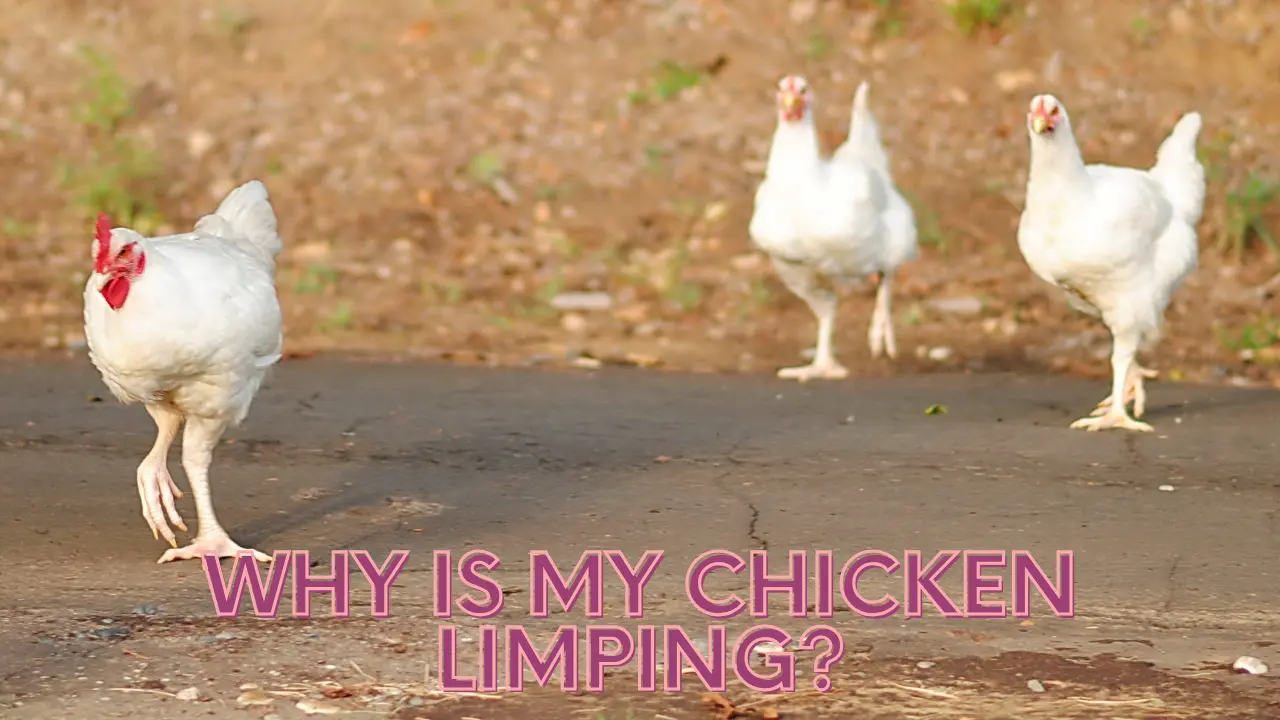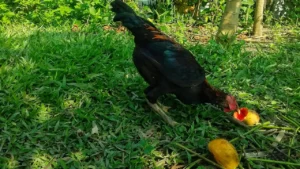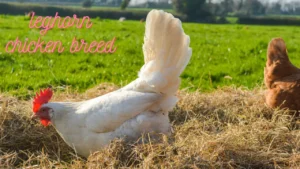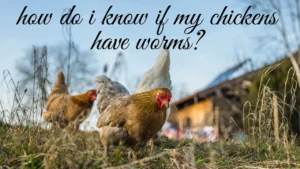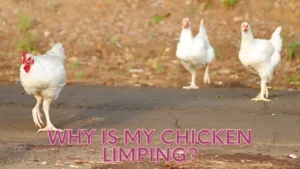Chickens are valuable members of your family and a great source of fresh eggs making their health and safety essential. If you notice limping, it could be due to a number of issues like a swollen leg, infected cut or something more serious. Chickens use their feet for activities such as scratching, perching, jumping and preening, so any discomfort should be promptly addressed. Regular checks of your flock’s legs and feet can help you discover potential problems before they become major concerns.
It’s important to keep an eye on your hens and observe their gait and behaviour for any signs of impending issues. While summer months may make it easier to spot problems without the mud and muck a weekly check is crucial. If there are no obvious signs sometimes it takes a bit of detective work to identify the cause of the limping. Early detection means problems are often easy to treat and will ensure a healthy, happy flock.
Why is My Chicken Limping?
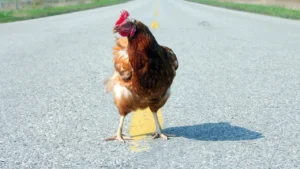
Here are some possible reasons why your chicken could be limping.
Bumblefoot: Bumblefoot is a common reason why a chicken may be limping. It’s a bacterial infection that often starts from a cut or abrasion on the footpad or sole. The infection can be caused by a puncture wound clod of mud or manure that gets stuck to the foot. If left untreated the infection can spread to the joint fluids and cause serious health problems, even leading to death.
Prompt treatment includes cleaning the wound draining the pus applying antibiotic spray and covering it with an absorbent pad and vet wrap to protect it from further damage. Regularly checking for signs of swelling and treating the area can help prevent more severe issues.
Scaly Leg Mites: Scaly leg mites are a common cause of limping in chickens. These mites burrow under the scales on the legs, causing irritation and making the scales raised and thickened. Infected hens may show lumpy legs with visible gaps between the scales.
The condition is caused by Knemidocoptes Mutans, a scaly leg mite which feeds on the keratin in the skin. To treat this clean the affected area, apply Vaseline to suffocate and kill the mites and use treatments that help heal the skin. If you suspect an infection, it’s essential to act quickly to avoid further damage and discomfort to your flock.
Wounds and Injuries:Chickens love to roost high but sometimes they jump down and injure their legs. They may also step on each other putting pressure on their tendon causing pain. If you notice limping it’s important to seek veterinary care to relieve the pain and suggest ways to help your chicken rest and heal.
Unwell Chickens: Chickens are like little garbage disposals and will try to eat almost anything, but there are some foods they shouldn’t consume. Moldy scraps dirty water or even just unsafe feed can lead to serious health issues like weight loss, depression, poor motor function and dehydration. It’s important to educate yourself on what is safe for your chickens to consume and take proper care of them to avoid these problems.
Environmental causes
Wet and muddy ground, along with faeces-covered runs and slippery surfaces, are common environmental causes of lameness in chickens. These conditions can lead to wounded feet or joints resulting in slips, sprains and even twisting of the leg. Additionally chickens may get caught on equipment netting or branches which can cause further injury.
To minimize these risks ensure ramps have a non-slip surface with spaced cleats to prevent accidents. It’s important to keep a watchful eye on your chickens’ gait and check for signs of any injury especially after a rainy day or when they are around slippery or dangerous areas like feeders and troughs.
Hatching & Chick Development
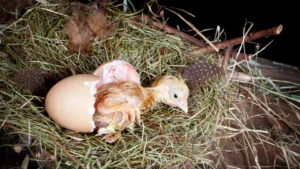
The way eggs are cared for during incubation can have a big impact on the chick’s health. Low humidity during this process can cause weak or even crippled chicks that are unable to stand after hatching. It’s essential to maintain proper humidity levels to prevent these issues. Additionally, slippery surfaces in hatching trays and brooders can cause splayed legs in newly hatched chicks making them more vulnerable to injuries.
Genetic problems can also contribute to lameness which might not be apparent right after hatching but can gradually worsen as the chick grows. In cases where the condition does not improve these chicks should be euthanised as they will likely not recover. Early attention and proper care during hatching can ensure a better chance for healthy development.
Essential Tips for Treating a Lame Bird
- Remove the bird from the flock and place it in a dry area with adequate food and water.
- Look and feel for a possible cause and consult a vet if you’re unsure.
- If it’s something obvious like bumblefoot treat it for a week and see if there’s a response.
- If there’s no improvement it’s best to cull the bird as it’s unlikely to recover.
- Don’t return the bird to the flock until it’s properly walking again, as an injured bird will be picked on by others and may reinjure itself.
- For young chicks with splayed legs a simple splint using sticky tape or plasters for a few days can help.
How to Keep Your Chickens Safe from Bumblefoot?
- Make sure there are no rough edges or jagged edges in the coop to prevent chickens from injuring their feet.
- Ensure you have the right sized perch for different sized birds with bantams needing thinner perches than heavy breeds.
- Keep perches low to the ground (around 40 cm) or create a ladder arrangement to reduce the risk injury when they jump down.
- Keep the coop litter dry and cover entry and exit points with gravel or bark chips to avoid mud puddles and easily wipe their feet clean.
- Ensure smooth perches with edges rounded so nothing can catch on their feet.
Dangerous Toxins
Chickens are at risk from moulds, bacteria, poisonous plants and household chemicals. These toxins can lead to neurological symptoms like limping, wobbly movements or even convulsions. Mouldy foods, dirty feed containers and damp soil are common sources. Toxic plants such as green berries from black nightshade and even green potato skins can harm your chicken’s nervous system. Fertilizers and paint flakes containing lead are also dangerous. If a chicken is exposed to these toxins they may experience inability to move, wobbliness or paralysis and in severe cases death.
To prevent toxic exposure avoid feeding chickens kitchen scraps or plants that could harm them. Be careful of everlasting pea seeds, kowhai seeds and even some wild plants in the garden. Coccidiostats like Monensin found in poultry feed can also affect birds like turkeys causing lameness. Always keep your chickens’ environment clean and ensure they do not ingest harmful substances.
FAQs about Why is My Chicken Limping?
Here are 10 FAQs about “Why is My Chicken Limping:
- Why is my chicken limping?
Limping can be caused by injury, infections like bumblefoot or even toxins. It’s important to identify the cause to treat it properly. - What is bumblefoot in chickens?
Bumblefoot is a bacterial infection in the foot, often caused by cuts or abrasions. It can make chickens limp and requires prompt treatment. - How can I tell if my chicken has a sprained leg?
A sprained leg may cause limping with no visible injury. Look for swelling or tenderness and consult a vet for proper care. - Can a chicken limp from being stressed?
Yes, stress from overcrowding, bullying or environmental changes can lead to limping. Reduce stress and monitor the chicken for improvement. - How do I treat a chicken with a limp?
Depending on the cause, rest, bandaging or applying an antibiotic may help. For serious injuries or infections, consult a vet. - Why is my chicken limping and not eating?
If a chicken is limping and not eating, it could be in pain or stressed. A vet’s diagnosis is essential to treat underlying issues. - Are old chickens more prone to limping?
Yes, older chickens may have weaker joints or arthritis, making them more prone to limping. Regular checkups can help manage these issues. - Can chickens limp from toxins in their food?
Yes, toxins like moldy food or certain plants can affect a chicken’s mobility, causing them to limp. Always feed chickens safe and fresh food. - How can I prevent my chickens from injuring their legs?
Keep their living space free from sharp objects and provide low, non-slip perches. Regular health checks can help detect early signs of injury. - Is limping a sign of a serious condition?
Not always, but limping can indicate conditions like sprains, infections or even nutritional deficiencies. It’s best to monitor and consult a vet if needed.
Conclusion
When your chicken starts limping, it’s important to act quickly to diagnose the cause. Why is my chicken limping can stem from a variety of factors such as injuries infections like bumblefoot or even toxins in their environment or food. By observing your chicken closely and providing the necessary care, you can often help them recover quickly. Regular health checks, a safe environment and proper nutrition are key to preventing limping issues in the future.
If your chicken continues to limp or shows signs of worsening health<span style=”font-weight: 400;”> seeking advice from a vet is always the best course of action. Why is my chicken limping might require professional help for more serious conditions. Early detection and treatment can save your chicken from further injury or long-term health problems. Whether it’s a sprain, infection or a nutritional issue addressing the problem swiftly ensures your flock remains happy, healthy and thriving.
